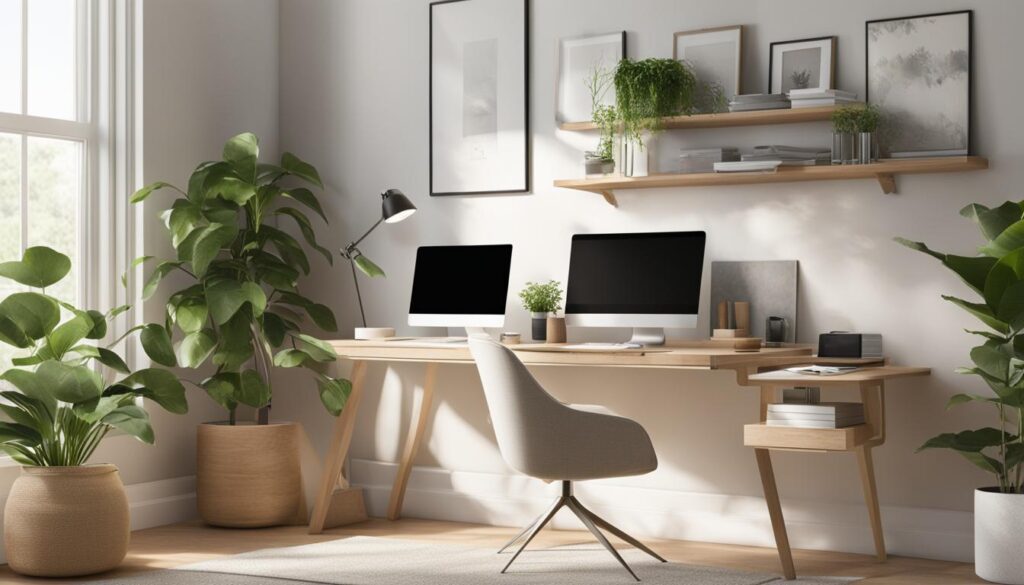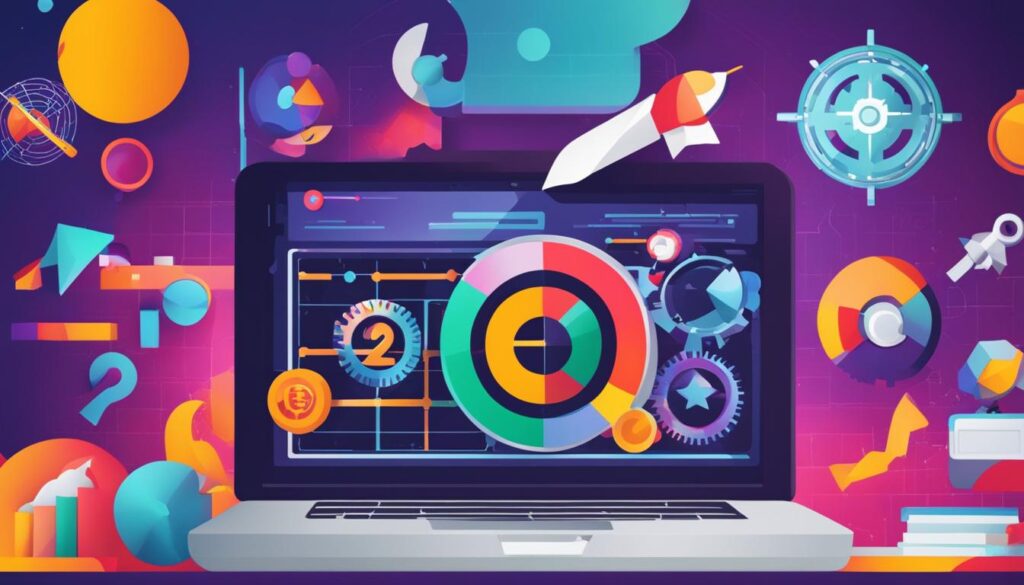We may earn money or products from the companies mentioned in this post.
Working from home can be a blessing, but it also presents unique challenges, including the distractions that come with being in your own space. Whether it’s children, pets, household chores, or digital diversions, maintaining focus and productivity can be a difficult task. Fortunately, there are practical steps you can take to create a distraction-free workspace that promotes concentration and efficiency. In this section, we’ll explore workspace organization, productivity tips, and workspace design to help you optimize your home office.
Key Takeaways
- Creating a distraction-free workspace is essential for productivity and reducing stress.
- Workspace organization is key to minimizing distractions and staying focused.
- Productivity tips like goal setting and time blocking can help you achieve your tasks efficiently.
- Optimizing your work environment with proper lighting, ergonomics, and personal touches can enhance concentration.
- Incorporating plants and colors can help create a pleasant workspace that promotes focus and creativity.
Eliminating Distractions for Better Focus
In today’s fast-paced world, staying focused at work can be challenging. From email notifications to chats, there are many distractions that can easily take you off track and decrease your productivity. If you struggle with maintaining your focus, try implementing these concentration techniques.
Minimize Interruptions
Interruptions can be a major distraction and can significantly reduce your productivity. To minimize interruptions, try setting specific times to check your emails or messages. You can also let your colleagues know when you are working on a critical project and ask them not to disturb you unless it is urgent.
Avoid Digital Distractions
Digital distractions such as social media, instant messaging, and online news can be a significant hindrance to your productivity. Try disabling notifications from non-work related apps during your working hours. Also, avoid having multiple tabs open on your web browser. Instead, use one window and close it once you are done with the task.
Create a Quiet and Clutter-Free Environment
A noisy and cluttered workspace can make it harder for you to concentrate. Try creating a quiet environment that is free from clutter. Use noise-cancelling headphones if you work in a noisy environment. Keep your workspace tidy and organized. You can use a desk organizer to keep your stationery and other items neatly arranged.
Take Breaks
To maintain focus, it is essential to take periodic breaks. Taking a break can help you refresh your mind and come back to your work with renewed focus. Try taking a five-minute break every hour or a 15-minute break every two hours. During your break, get up from your desk, stretch, and move around to increase blood flow to your brain.
Use the Pomodoro Technique
The Pomodoro technique is a time management technique that can help you improve your focus and productivity. The technique involves working for 25 minutes and then taking a five-minute break. After four work periods, take a longer break of around 15-20 minutes. This technique can help you stay focused on your task and avoid distractions.
Conclusion
Eliminating distractions is crucial for maintaining focus and being productive at work. By implementing the techniques outlined above, you can minimize interruptions, avoid digital distractions, create a quiet and clutter-free environment, take breaks, and use the Pomodoro technique. These techniques can help you stay focused and accomplish your tasks efficiently.
Optimizing Your Work Environment
Your work environment can play a significant role in your ability to focus and be productive. By optimizing your workspace with the right design and organization, you can create an environment that promotes concentration and minimizes distractions.
Work Environment Suggestions
When designing your workspace, consider the following suggestions:
- Ensure adequate lighting to reduce eye strain and fatigue
- Choose a comfortable chair and adjust it to the appropriate height for your desk
- Keep your desk organized and clutter-free to minimize distractions
- Incorporate personal touches like photos or artwork to make the space feel more inviting
In addition to these suggestions, you may also want to consider the benefits of incorporating plants into your workspace. Research has shown that plants can improve air quality, reduce stress, and increase productivity.
Workspace Design
The design of your workspace can also play a crucial role in your ability to focus and be productive. Consider the following design elements:
| Design Element | Description |
|---|---|
| Color | Choose calming colors like blue or green to promote a sense of relaxation and focus |
| Layout | Arrange your workspace in a way that minimizes distractions and maximizes natural light |
| Ergonomics | Choose furniture and equipment that is comfortable and promotes good posture |
By incorporating these design elements into your workspace, you can create an environment that supports focus and productivity.
Concentration Techniques
Finally, it’s essential to develop concentration techniques that work for you. Consider the following:
- Establish a routine that includes regular breaks to refresh your mind
- Use headphones or earplugs to block out noise
- Turn off notifications on your devices to minimize digital distractions
- Use a timer to break your work into manageable chunks and stay focused
By practicing these techniques and optimizing your work environment, you can create a distraction-free workspace that promotes focus and maximizes productivity.
Productivity Tips for a Distraction-Free Workspace
Working from home comes with its share of distractions. However, it’s possible to create a workspace that promotes focus and helps you achieve more in less time. Here are some productivity tips to help you maintain a distraction-free working environment:
Goal Setting
Setting goals is crucial to staying on track and avoiding distractions. By setting realistic and achievable goals, you can prioritize your tasks and focus on what’s essential. Use a planner or digital tool to jot down your daily, weekly, and monthly goals. Ensure they align with your objectives. As you complete each task, tick it off your list to gain a sense of accomplishment and motivate yourself to continue.
Time Blocking
Time blocking involves breaking down your workday into blocks of time dedicated to specific tasks. By doing this, you can ensure that you allocate enough time to complete critical tasks and minimize the chances of getting sidetracked. The key is to schedule your most critical tasks during your peak productivity times and take breaks when you feel your productivity flagging. Use a timer to monitor your progress and stay on track.
Prioritization
Prioritization is crucial to maintain productivity and reach your goals. To prioritize your tasks, use the Eisenhower matrix. This matrix categorizes tasks into four categories – urgent and important, not urgent but important, urgent but not important, and not urgent or important. This categorization will help you focus on critical tasks and delegate or delete less important ones.
Workspace Organization
A cluttered workspace can be a significant distraction. Declutter your workspace regularly to maintain a clear headspace. Use folders, trays, and organizers to keep files, paperwork, and other office supplies in their designated spots. Label everything to reduce the time spent searching for items. Use a planner or calendar to schedule cleaning and decluttering sessions.
Concentration Techniques
Concentration techniques such as meditation, deep breathing, and exercise can help you stay focused and calm. Practice meditation or deep breathing exercises for five to ten minutes before you begin work to center your mind and reduce stress. Take regular breaks to stretch and move your body, increasing blood flow to your brain and reducing fatigue. These concentration techniques can help you maintain focus and avoid distractions.
By implementing these productivity tips, you can create a distraction-free workspace that promotes focus, productivity, and success. So, get started today and see how much more you can achieve.
Conclusion
Creating a distraction-free workspace at home is crucial for staying focused and achieving your professional goals. By following the tips and techniques outlined in this article, you can design an optimized work environment that enhances your productivity and reduces stress.
Remember the Basics
Start by decluttering your workspace and minimizing distractions such as noise and digital interruptions. Optimize your work environment with appropriate lighting, ergonomic furniture, and personal touches that inspire you.
Stay Focused
Eliminating distractions is only the first step. You also need to cultivate strong concentration skills to stay focused. Consider techniques such as time blocking and goal setting to manage your workload effectively.
Prioritize Your Productivity
Finally, prioritize productivity by maintaining an organized workspace and minimizing interruptions. Remember that a distraction-free workspace is not just about physical surroundings but also mental clarity. Take regular breaks and practice stress-reducing activities such as mindfulness and exercise to boost your productivity and well-being.
Implementing these strategies will help you create a workspace that supports your professional success and allows you to work at your best.
FAQ
What are some tips for creating a distraction-free workspace at home?
To create a distraction-free workspace at home, consider the following tips:
– Choose a dedicated area for your workspace.
– Keep your workspace clean and organized.
– Minimize noise and interruptions.
– Set boundaries with family members or roommates.
– Use productivity tools and techniques to stay focused.
How can I eliminate distractions and improve focus in my workspace?
To eliminate distractions and improve focus in your workspace, try these techniques:
– Turn off notifications on your devices.
– Close unnecessary tabs or apps on your computer.
– Use noise-cancelling headphones or play background music.
– Create a visual barrier between your workspace and other areas of your home.
– Establish a routine and stick to a schedule.
What are some suggestions for optimizing my work environment?
To optimize your work environment, consider these suggestions:
– Ensure proper lighting in your workspace.
– Use an ergonomic chair and desk setup.
– Keep essential items within reach and neatly organized.
– Incorporate plants or natural elements for a calming atmosphere.
– Personalize your workspace with decor or artwork that inspires you.
How can I boost productivity in a distraction-free workspace?
To boost productivity in a distraction-free workspace, try these tips:
– Set clear goals and prioritize tasks.
– Use time-blocking techniques to manage your schedule.
– Take regular breaks to recharge and avoid burnout.
– Maintain a clutter-free workspace for better focus.
– Use productivity apps or tools to track your progress.
Why is creating a distraction-free workspace important for productivity?
Creating a distraction-free workspace is important for productivity because it allows you to focus and concentrate on your tasks without interruptions. By eliminating distractions, you can work more efficiently, stay organized, and accomplish your goals in less time. A well-designed workspace promotes a positive mindset and helps you maintain momentum throughout the day.
Affiliate Disclosure: This post may contain affiliate links. If you purchase through our link, we may receive a small commission, but at no additional cost to you. For more information, please see our Disclosure statement.


